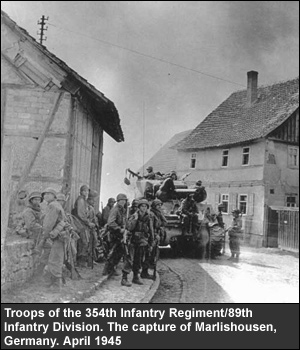 |
|
Central Europe: Beginning of the End
As 3rd Battalion, 355th, prepared to join with tanks in an assault on the ancient city, Gotha surrendered. More than a thousand prisoners and large quantities of supplied were captured. The tank-infantry team at this time was fifty miles ahead of all adjacent troops and the force was ordered to wait until the rest of the Division had secured the autobahn and cleared Eisenach. Supply trucks operating over the extended communications line were forced to run a perilous gantlet of strafing by German planes and several vehicles, including a truck hauling gasoline, were knocked out. CT movements took a line running from Henningsleben through Wiegleben to Westhausen. This located the Division near the so-called Werra River Line, and launched the drive to the Saale River. These and other small rivers afforded the Germans natural defense barriers, but they chose instead to fall back through the dense Thuringian Forest, using it as an escape route. Much of the heaviest fighting took place there. As this offense developed, it became evident that the Wehrmacht in central Germany was finished as an effective fighting force. Hitler's much-vaunted inner core was largely defenseless, without air, armor or first-class troops. In some places SS troops held out stubbornly. More often civilians flew the while flag from their houses and PWs surrendered by the hundreds as Third Army armor and infantry teams ripped deep into the bleeding heart of the defeated Reich.
|

 Earliest opposition was stiffest in CT 3's zone. Attacking Fortha to clear the approach to Eisenach, the 3rd Battalion, 353rd, clashed with a pocket of 300 SS men and stragglers, meeting heavy small arms, Panzerfausts and automatic weapons fire, but cleared the town by 1700, April 5. On the left, CT 4 advanced more rapidly against light opposition to reach the vicinity of Wangenheim. The 1st Battalion moved to Wagenleben. Isolated German planes were active in the Division forward area, strafing bridges and supply columns on the superhighway.
Earliest opposition was stiffest in CT 3's zone. Attacking Fortha to clear the approach to Eisenach, the 3rd Battalion, 353rd, clashed with a pocket of 300 SS men and stragglers, meeting heavy small arms, Panzerfausts and automatic weapons fire, but cleared the town by 1700, April 5. On the left, CT 4 advanced more rapidly against light opposition to reach the vicinity of Wangenheim. The 1st Battalion moved to Wagenleben. Isolated German planes were active in the Division forward area, strafing bridges and supply columns on the superhighway.